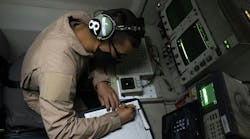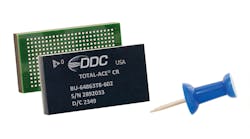WRIGHT-PATTERSON AFB, Ohio, 27 March 2013. Northrop Grumman Corp. is joining a U.S. military research effort to develop a prototype sensor fusion system for land, sea, and airborne applications that can accept inputs from several kinds of navigation sensors so that warfighters can maintain navigation capability with or without Global Positioning System (GPS) satellite navigation.
Navigation and guidance engineers at the Northrop Grumman Corp. Navigation and Maritime Systems Division in Woodland Hills, Calif., won a contract for the second phase of the All Source Positioning and Navigation (ASPN) program of the U.S. Defense Advanced Research Projects Agency (DARPA) in Arlington, Va.
Northrop Grumman Navigation and Maritime won a $1.3 million contract on 20 March for the DARPA ASPN phase 2 project, which seeks to develop algorithms and a prototype sensor-fusion system to enable low cost navigation for military users on any operational platform and in any environment, with or without GPS.
With the addition of Northrop Grumman the number of ASPN phase 2 contractors grows to five. SAIC Inc. in McLean, Va., won the initial contract in late January, and other ASPN phase 2 contractors are Vesperix Corp. in Arlington, Va.; SRI International in Menlo Park, Calif.; and Systems & Technology Research in Woburn, Mass.
Awarding the contract were officials of the U.S. Air Force Research Laboratory at Wright-Patterson Air Force Base, Ohio, on behalf of DARPA. Vesperix won a $107,229 contract; SRI won a $1.3 million contract; Systems & Technology Research won a $313,790 contract; and SAIC won the a $2.9 contract.
DARPA awarded first-phase ASPN contracts early last year to the Charles Stark Draper Laboratory Inc. in Cambridge, Mass., and to Argon ST Inc. in Fairfax, Va. In the first phase of ASPN, Draper Lab and Argon ST experts focused on developing navigation algorithms, and a navigation software architecture. Draper Lab's contract was for $599,923, and Argon ST's contract was for $1.9 million.
In the initial phase of the ASPN program, scientists from Draper Lab and Argon ST concentrated on developing the architectures, abstraction method, and navigation filtering algorithms necessary for rapid navigation sensors integration and reconfiguration.
In essence, the companies showed that an adaptable, plug-and-play capability for navigation systems is achievable. Now SAIC, Vesperix, SRI, and Systems & Technology Research will bring this technology to the next level.
In the program's second phase researchers from the five companies will continue algorithm development build a prototype ASPN system for demonstration and evaluation. The companies not only will develop real-time algorithms, but also will field these algorithms on size-, weight-, and power (SWaP)-representative prototype hardware able to accept an arbitrary set of inputs, regardless of native application of the sensors used.
Most current navigation systems rely on a combination of GPS, inertial measurement unit (IMU), and sometimes other navigation sensors to provide accurate positioning and navigation information, DARPA researchers say.
Military navigation systems designers want to improve their systems by combining different sensors, such as laser rangers, cameras, and magnetometers. The problem, however, is today's navigation sensors usually have custom filtering for their specific sensors, and are not readily adaptable to new capabilities and threats.
The ASPN program seeks to develop new navigation sensor fusion technology that can accommodate any combination of sensors in a plug-and-play fashion to create robust positioning and navigation technology in the face of new battlefield conditions and missions, while reducing costs.
SAIC specializes in cyber security; engineering; health; intelligence, surveillance, and reconnaissance (ISR); and logistics, readiness, and sustainment. Vesperix concentrates on software and integrated systems low-cost, low-power computing; cost-effective RF systems; imaging techniques; and handheld location and navigation.
SRI is an independent nonprofit research institute for government and private business that specializes in computing; security and defense; sensing and devices; biomedical sciences and health; and related fields. Systems & Technology Research, concentrates on sensor and information processing technologies for military, intelligence, and homeland security applications. Northrop Grumman is a longtime developer of advanced navigation equipment for aircraft, maritime vessels, and land vehicles.
For more information contact Northrop Grumman Navigation and Maritime Systems online at www.northropgrumman.com; SAIC at www.saic.com; Vesperix at www.vesperix.com; SRI International at www.sri.com; and Systems & Technology Research at www.stresearch.com.
Also contact the Air Force Research Lab at www.wpafb.af.mil/AFRL or DARPA at www.darpa.mil.



